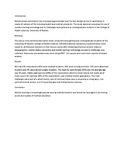Use of mobile learning technology among final year medical students in Kenya

View/
Date
2015Author
Masika, Moses M
Omondi, Gregory B
Mugane, Ephraim M
Bosire, Kefa O
Kibwage, Isaac O
Language
enMetadata
Show full item recordAbstract
Introduction
Mobile phone penetration has increased exponentially over the last decade as has its application in nearly all spheres of life including health and medical education. This study aimed at assessing the use of mobile learning technology and its challenges among final year undergraduate students in the College of Health sciences, University of Nairobi.
Methods
This was a cross-sectional descriptive study conducted among final year undergraduate students at the University of Nairobi, College of Health Sciences. Self-administered, anonymous questionnaires were issued to all final year students in their lecture rooms after obtaining informed consent. Data on demographics, mobile device ownership and mobile learning technology use and its challenges was collected. Data entry and analysis was done using SPSS®. Chi-square and t-test were used for bivariate analysis.
Results
We had 292 respondents; 62% were medical students, 16% were nursing students, 13% were pharmacy students and 9% were dental surgery students. The majority were female (59%) and the average age was 24 years. Eighty eight percent (88%) of the respondents owned a smart device and nearly all of them used it for learning. 64% of the respondents used medical mobile applications. The main challenges were lack of a smart device, lack of technical know-how in accessing or using apps, sub-optimal internet access, cost of acquiring apps and limited device memory.
Conclusion
Mobile learning is increasingly popular among medical students and should be leveraged in promoting access and quality of medical education.
Citation
Pan Afr Med J. 2015; 21: 127.Publisher
University of Nairobi
Collections
- Faculty of Health Sciences (FHS) [10415]
